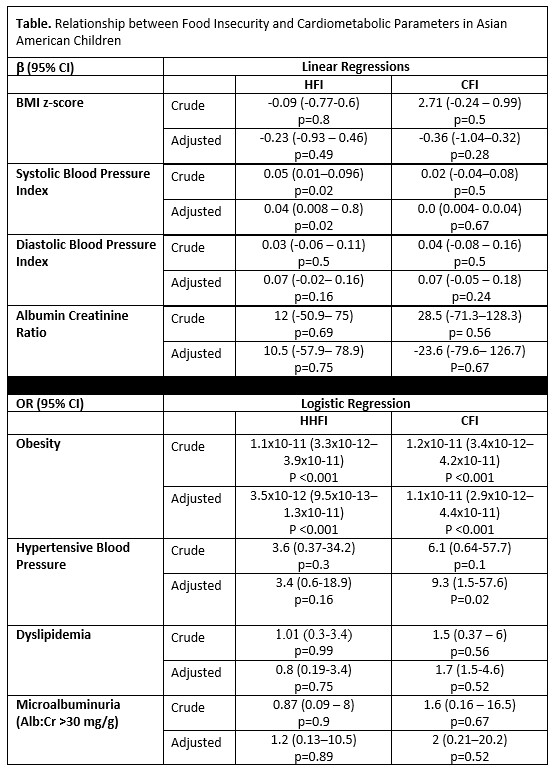Health Equity/Social Determinants of Health
Session: Health Equity/Social Determinants of Health 8
313 - Food Insecurity and Cardiometabolic Health in Asian American Children
Sunday, May 5, 2024
3:30 PM - 6:00 PM ET
Poster Number: 313
Publication Number: 313.2091
Publication Number: 313.2091

Rahael A. Achett (she/her/hers)
11th grade highschool
Cohen Children's Medical Center
Chicago, Illinois, United States
Presenting Author(s)
Background: Although there are 4 million Asian American children in the United States (US), food insecurity in this population has not been well studied. Additionally, the impact of food insecurity in Asian American children on cardiometabolic health is unknown.
Objective: To investigate the prevalence of food insecurity in a nationally representative sample of Asian American children compared to Non-Hispanic White children and to determine the association of food insecurity with childhood obesity, blood pressure (BP), dyslipidemia, and microalbuminuria.
Design/Methods: Children ages 6-17 years who self-identified as non-Hispanic Asian and non-Hispanic White (NHW) enrolled in the Nutrition Examination Survey (NHANES) from 2011-2018 were included in this cross-sectional analysis. Household food insecurity (HFI) and childhood food insecurity (CFI) were defined based on a Food Security Survey Module score ≥3 and ≥4 respectively, indicating low and very low food security. For Asian American children, complex sample regression models adjusted for age, sex, body mass index (BMI), poverty income ratio, and passive smoke exposure examined associations of HFI/CFI with cardiometabolic health. BP was indexed to the 95th%ile (SBPi/DBPi). Hypertensive BP was classified based on casual BP ≥95th%ile for children < 13 years or ≥130/80 mmHg for children ≥13 years. Dyslipidemia was defined as non-HDL ≥145 mg/dL, HDL < 40 mg/dL, LDL ≥130 mg/dL or triglycerides ≥130 mg/dL. Urine albumin: creatinine >30 defined microalbuminuria.
Results: Of the 917 Asian American children studied, the mean age was 14.6 years, 51% were female, 4.2% were obese, with a 0.79% and 0.7% prevalence of systolic and diastolic hypertensive BP, respectively. The prevalence of HFI (Asian American 11.2% vs NHW 16.7%, p=0.25) and CFI (Asian American 7.1% vs NHW 8.2%, p=0.75) was not significantly different in Asian American children compared to their Non-Hispanic White counterparts. Among Asian American children only, HFI was independently associated with higher SBPi and higher odds of obesity. CFI was independently associated with higher odds of hypertension and obesity (Table).
Conclusion(s): HFI and CFI were not uncommon in Asian American children and were associated with cardiometabolic health outcomes of hypertension and obesity. This association warrants further research to consider preventive measures in this understudied population.

